This article contains expert-led insights from a previous season of the Million Dollar Case Study.
MDCS is a free, comprehensive video series by Jungle Scout in which veteran Amazon sellers show budding entrepreneurs how to succeed on Amazon—by actually doing it. The series takes viewers step by step through the process of launching a real product on Amazon in real time—from product research to finding a supplier to advertising.
Check out our most current season here for the latest information on selling on Amazon.
Learn How To Find Products To Sell On Amazon
- In this episode, we cover how to find products to sell on Amazon.
- Our tips and tricks in conducting successful FBA product research.
- What are the characteristics of a bestselling Amazon product?
- How to use the Jungle Scout Database, Product Tracker, and the Chrome extension to find top selling products with low competition?
- FREE Million Dollar Case Study workbook at the end!
- Missed an episode? See them all here.
This is the Million Dollar Case Study. What to sell on Amazon? How to find products to sell on Amazon? How to make money on Amazon?
We’re covering all of this today in our second episode of the Million Dollar Case Study. Watch the video, keep reading and don’t forget to download your FREE MDCS Workbook at the end of this blog post!
Subscribe to the Million Dollar Case Study list here, so you never miss an episode!
Before you get started, if you’re not already using Jungle Scout, you will need to get a Jungle Scout subscription to follow along with us and complete your product research.
Welcome to the Million Dollar Case Study!
Welcome to The Million Dollar Case Study: Season 4, Episode 1. If you’re not familiar with The Million Dollar Case Study this is where we build and scale a physical products company to $1 million in revenue. All of the proceeds we earn from our products go to a charitable cause.
We do everything publicly and fully transparently. This is Season 4, which means we’ve done this three times before. In Season 1 we launched the bamboo marshmallow sticks. In Season 2 we launched the hooded baby towels. In Season 3 we launched the Jungle Slumber sleeping bags and this is Season 4 where we are kicking it up a notch and doing things a little bit differently (more on that in a moment).
How to Find a Product to Sell on Amazon
By the end of this blog post, you’re going to know exactly how to find profitable products to sell on Amazon, how to track those products, and how to quickly and effectively do product research.
What does it take to have a successful product on Amazon? What kind of characteristics do these successful products have?
What we recommend and what we are going to be teaching you throughout this case study is how to find a product or niche that meets the following criteria:
- Existing solid demand
- Low competition
- Good margins
- No legal issues
- Ability to improve (we call this Customer Driven Innovation™)
This season we coined the term Customer Driven Innovation™. This product research strategy is halfway between an invention and private labeling. It leverages Jungle Scout to find products that sell well, but are lacking key elements or features to make them truly appealing to users. It involves looking at sales, ratings, and reviews.
But don’t be overwhelmed by this. You don’t need to be an inventor or some market research guru. We are just going to physically give this feedback to our factories and we’re going to work with them to make these improvements to the products.
Now that we have covered our “must haves” let’s take a look at some “nice to have” criteria for a good private label product:
- Small/ lightweight
- Easy to source and ship
- Low seasonality
- Simple and durable
- Weird and interesting
Finding a Bestselling Amazon Product
We are looking for a product or niche on Amazon that the top 10 sellers have at least 2,000 sales per month. This is very important because often times, where beginners fail, is that they try to sell a product on Amazon that they think will do well because of a hot tip they received from a friend or family member or that they found online, however, that’s a very dangerous way to go about selling products on Amazon.
Instead of trying to guess what people are going to buy on Amazon, we can just go into Jungle Scout and we can figure out exactly what people are purchasing.
You should look for strong minimum sales for each product, play with numbers like 250-500 minimum sales per month.
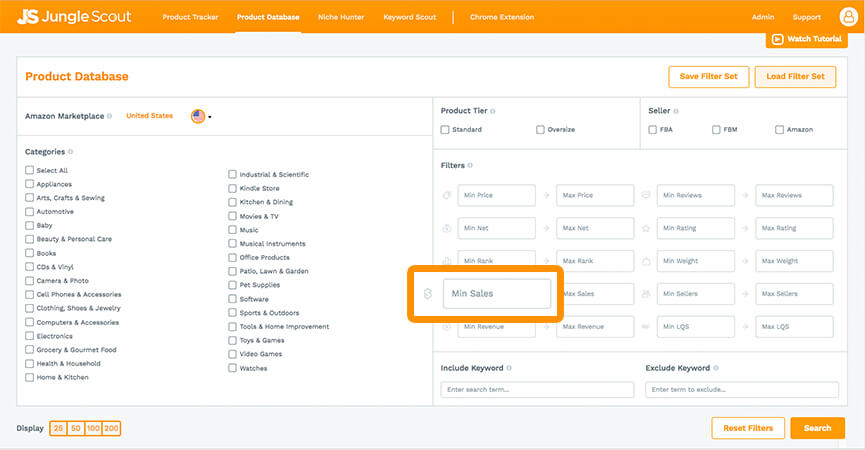
You can use Jungle Scout to make your product research faster and easier. Click here!
Find an Amazon product with low competition
The best way to gauge the level of competition is to look at how many reviews your competitors have and how many people are selling a very similar product.
Now, in the top 10 sellers I like to find three or more that have less than 50 reviews and if I look at the first page of results for my product I don’t want to see everyone selling the exact same product.
If you were to search the term “garlic press” or “yoga mat” or some other products right now what you would find is it’s very difficult to differentiate your product from everyone else. The whole first page results all look the same and this would indicate that this is a very competitive market that’s hard to get into. Furthermore, I’m looking for something in the top 10 sellers that has three or more sellers that have 50 or fewer reviews. If all of the sellers have hundreds or thousands of reviews that means this is a very competitive market. Those sellers and listings have been around for a very long time and it’s not one that I recommend you get into.
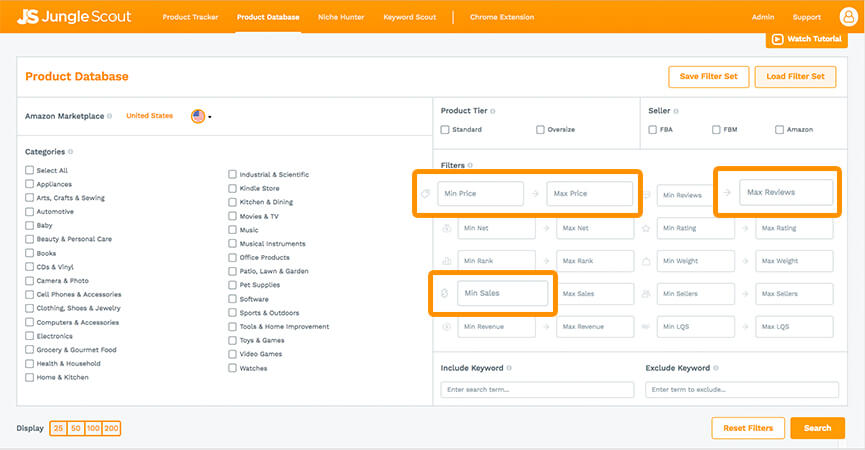
You also need to find a product with good margins.
If you’re selling an item for eight bucks or 10 bucks, after Amazon fees and getting it into Amazon and marketing, it’s hard to make more than a dollar or two on those. We want to be selling products that are more expensive, let’s say $18 or more because those tend to have better margins and just the overall profit per unit tends to be higher.
If you’re selling 10 units a day and you’re only making a dollar each, that’s only $10 a day in profit. In comparison if you’re making five dollars or eight dollars profit now you’re making $50 a day or $80 a day, which is a lot more and just adds up a lot quicker.
Since this is the Customer-Driven Innovation™ Edition, we would like to see one or two sellers that are selling at least about 200 units per month that have a 3.7-star rating or worse.
We’re using 3.7 stars because that shows up to the customer as 3.5 stars and that’s a pretty bad rating on Amazon. I don’t know about you but I don’t ever purchase anything on Amazon if it doesn’t at least get 4 or 4.5 stars.
So the fact that people are still purchasing a lot of these units even though they get rated very poorly on Amazon is a great indicator to us that we can make improvements on this product and sell a lot better than these other competitors.
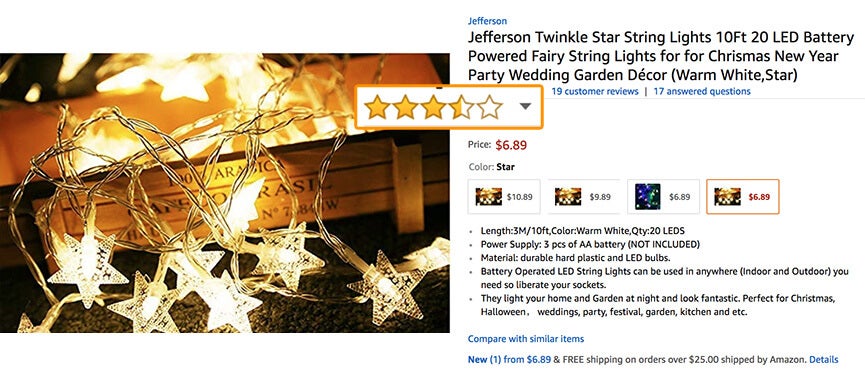
This is also just a timeless business strategy. Take the products that people are looking for and purchasing even though they don’t like them very much, improve upon it, and then sell it to that same crowd. This is something that will never go out of style.
Using the Jungle Scout Product Database
The Product Database is essentially us rebuilding Amazon’s entire product catalog in a way that’s user-friendly for sellers to search through and will allow you to do all this searching and filtering that’s beneficial to you as an Amazon seller.
We’re going to start off by making some category selections. Here are some categories to avoid. Don’t look for these:
- Books
- Kindle Store
- CDs & Vinyl
- Movies & TV
- Software
- Clothing, Shoes & Jewelry
- Watches
- Electronics
- Appliances
In the image below, you can see the categories I’ve left us to work with. These are some of the product categories with the best potential for private label products for Amazon FBA.
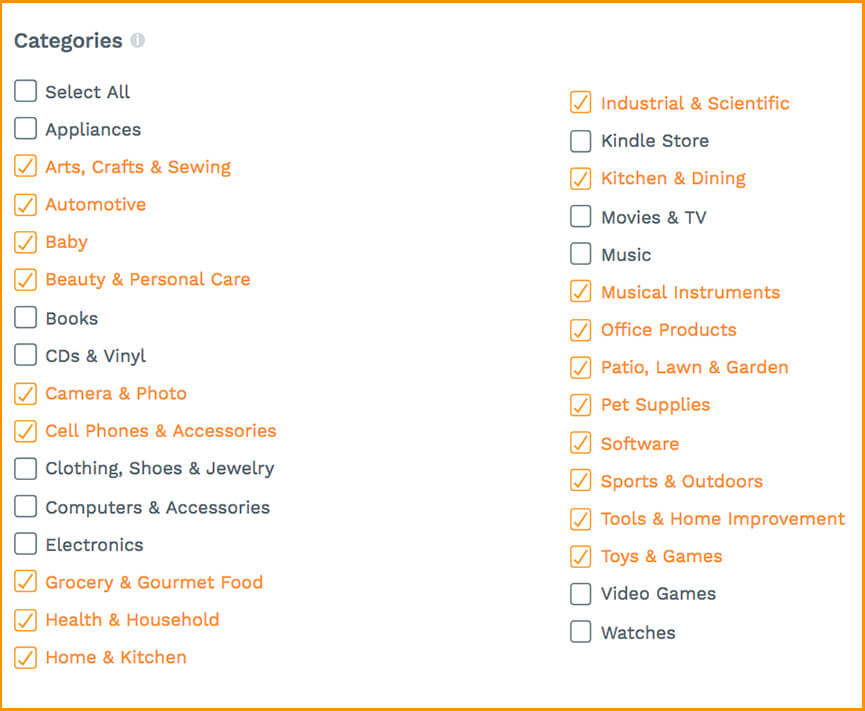
If we just chose these categories, it would give us a MASSIVE list. So, we want to make sure and refine our list using some of the filters I mentioned above. Let’s input the data for all of the following filters:
- Min Price: 18
- Min Sales: 200
- Min Reviews: 5
- Max Reviews: 50
- Max Rating: 3.7
And Voila! Like magic, we have our curated list of product ideas!
We started with tens of millions of products and this search has narrowed it down to thousands. That’s still a lot of products but the idea here is to quickly scan through this filtered list.
Whenever you see a product you like the look of (and the data for), collect them in your Product Tracker.
Get access to the Jungle Scout Product Tracker right away!
Using the Jungle Scout Product Tracker
Now, the best way to collect these different product ideas is inside of the Product Tracker. So, as I’m going through the product list I can quickly add a product by clicking the plus button in the upper right corner:
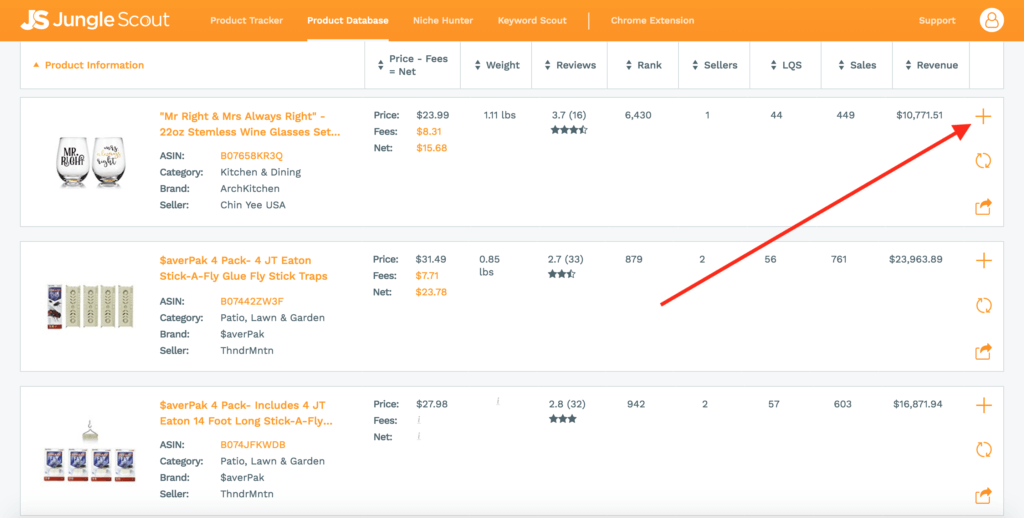
Now, what this will do is this will track these products for you on a daily basis. I can actually look back for previous information and see how many sales this product has had each individual day. Over time, you can see these products and see how many units are selling on a daily basis. You can see if there’s any kind of seasonal trends, or maybe if they do a promotion that day and the sales are artificially inflated. So, this is very beneficial to do.
As I’m going through these products I come up with as many product ideas as I can, and then I would have a bunch of tabs along the top of the Product Tracker, and place all the products inside of those categories that correspond to them. This keeps your categories very neat and tidy.
![]()
Ok, now we’re getting somewhere. What do we do next with all of these fabulous product ideas? Well, the idea is we begin to dive deeper and validate these ideas even further. I’m going to do that with Extension.
Using Extension
Extension helps to really speed things up when it comes to product research. Within a few seconds, I can see all of the products on the first page, I can see all the product names, I see the price, I see the rank, I see the unit sales per month, which is very valuable information. I see things like the number of reviews and the star rating, and I also see how much money is left over on these products, after Amazon takes their cut.
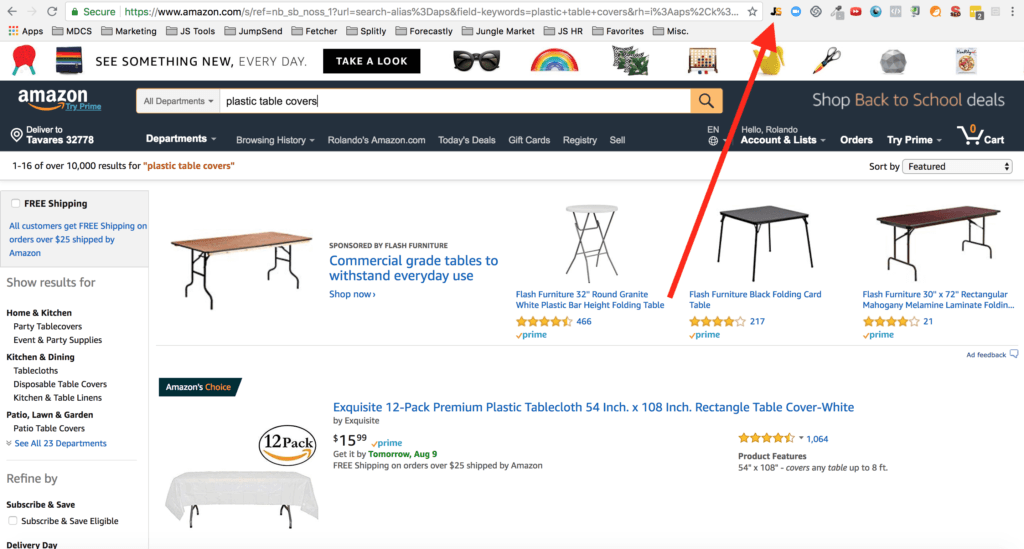
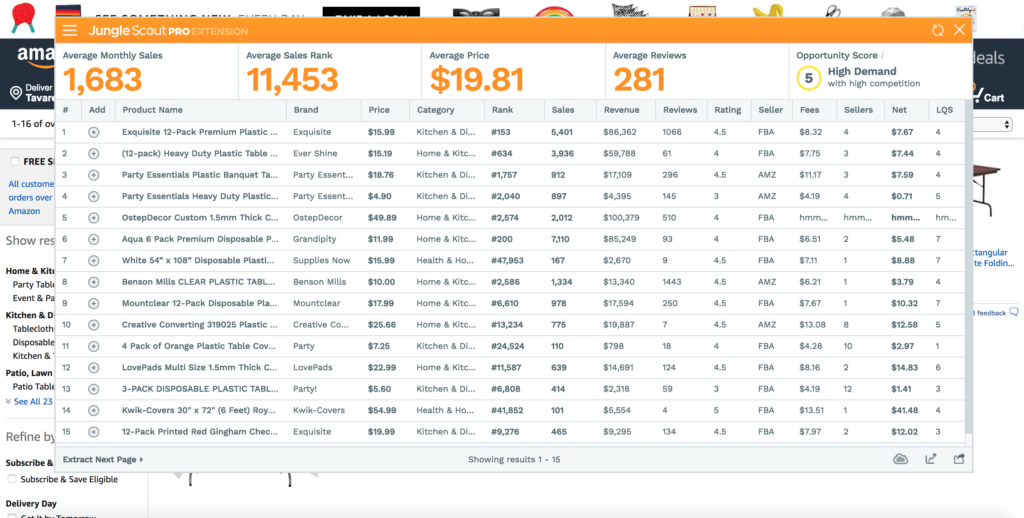
In the example above you can see the results generated when I ran the extension on the keyword “plastic table covers”.
Remember, I’m looking for at least about 2,000 units sold among the top 10 sellers, and ideally, there’s not just one seller selling all of those units.
Some other things to note just real quickly is you could also click on the rank inside of Extension, and this shows you how the rank has trended. So, I can zoom in on this. This is just the best sellers rank in its parent category, so, I can see how this has trended over the years or seasons. I could also click on the price to get a gauge of its price over the years.
While we’re on the Chrome extension, there are a couple of other just quick little notes. I can go into the columns, I can adjust which columns are being displayed. So, it can also show you things like the number of sellers, the dimensions, the weight, it can show you the sponsored products. I can also filter in here to say, “Hey, only show me the products that are selling at least,” let’s say, “1,300 units per month”.
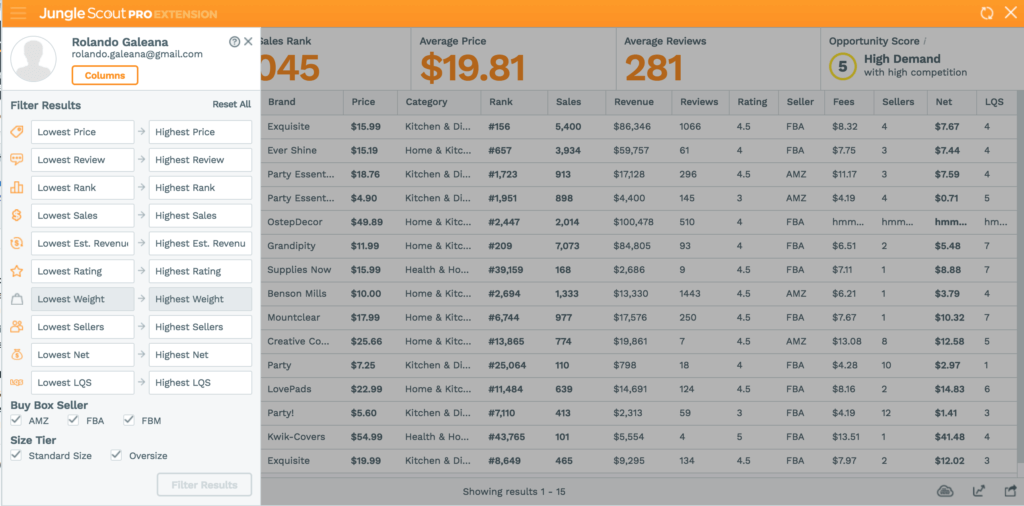
Lastly, let’s take a look and see why some of these plastic table covers are getting bad reviews and see whether or not we can improve on these products and work with the factories to improve them. So, I just went into a plastic table cover listing. I’m going to click on the numbered reviews and then click on the one stars to read the worst reviews and see what people don’t like about this potential product.
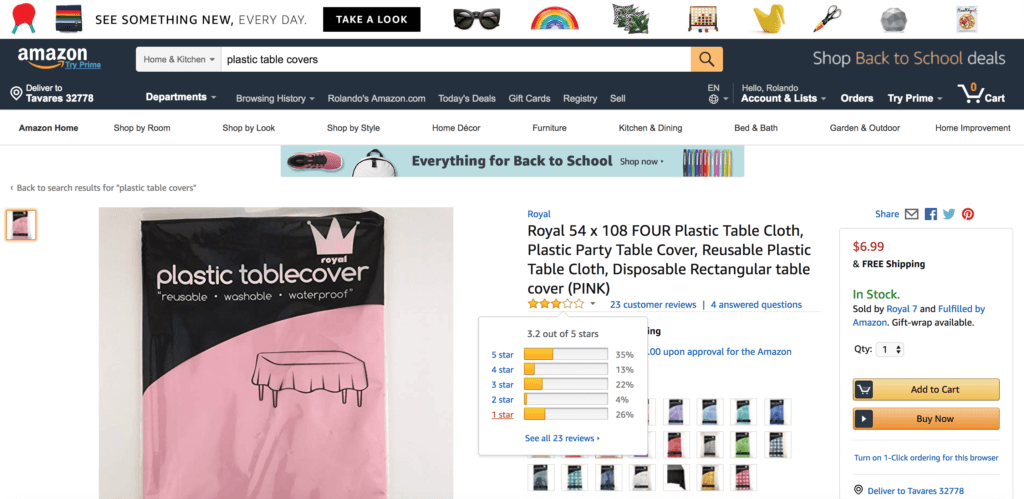
Here a few of the 1-star negative review comments:
- “Like tissue paper.”
- “Quality is poor.”
- “Not heavy duty.”
- “Rips easily.”
- “Dirty.”
- “It lasted a day then it tore.”
- “Very bad.”
- “As thin as Saran wrap.”
So, it’s pretty clear to me that the biggest problem with this particular product is the material is just too thin. Now, I’ve worked with a lot of factories in China, and I’ll tell you, the cost between a very thin plastic tablecloth and a thick plastic tablecloth actually probably isn’t very much and to get one of these very cheaply made is probably a quarter in China, and to get a heavy duty one is probably 30 or 35 cents. So, something like this would be very inexpensive to make improvements to it. So, this would be a good candidate for the type of product that we want to sell in Season 4.
We want to read the poor customer reviews, figure out what we can do to improve on them, and then sell that type of product.
Now, it’s YOUR TURN!
Start selling on Amazon today
Your Amazon success starts with Jungle Scout.
Start doing some research of your own! With every blog post, we’ll be challenging you with “Action Items” to make the most of your MDCS journey.
This weeks Action Items can be found here, in your FREE MDCS Workbook!
After you’ve completed your Action Items, post your progress to the Million Dollar Case Study Facebook Group! You don’t have to reveal all of your best ideas – just let us know you’re working on them! You can also post them to Instagram with the hashtags #mdcschallenge or #freedombuilders.
We donate 100% of our product proceeds to Pencils of Promise.
They build schools in developing countries to help children get access to the education they need for a strong foundation.
We love doing the Million Dollar Case Study. It’s a team-wide effort and we value every opportunity it gives us to connect with sellers like you.

 63 Comments
63 Comments
63 comments on “Million Dollar Case Study: How to Find Products to Sell on Amazon”